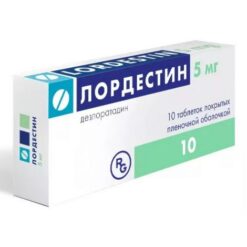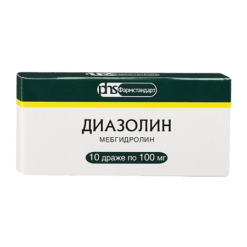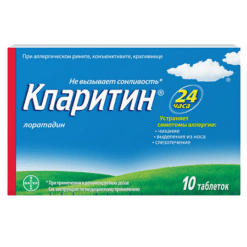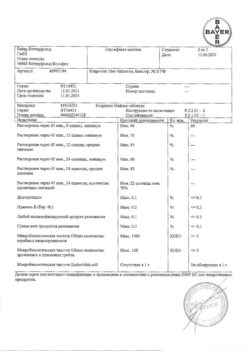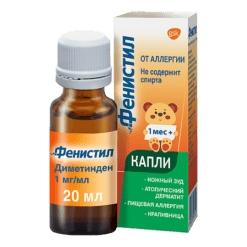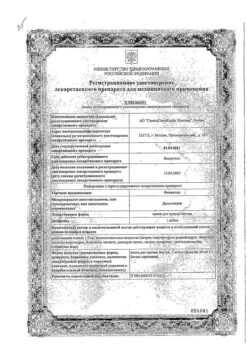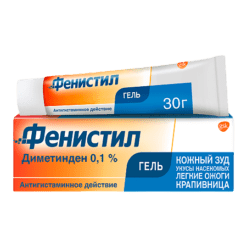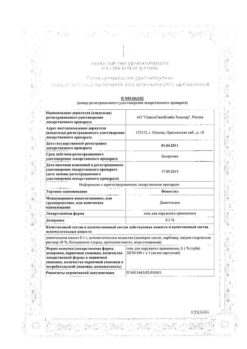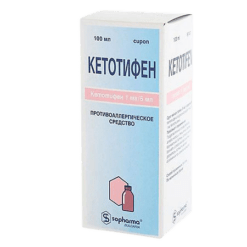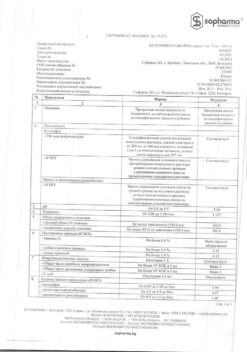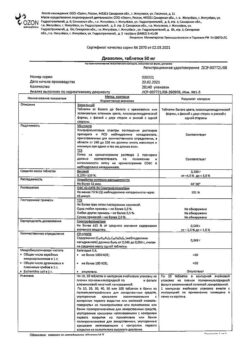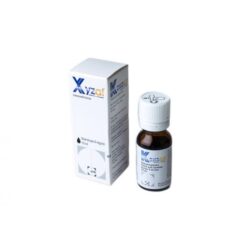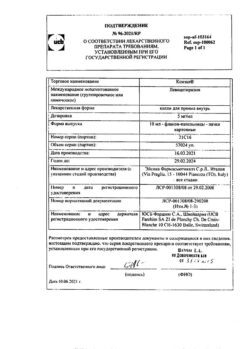No products in the cart.
Description
Parlizine is an anti-allergic agent.
Pharmacodynamics
Cetirizine is a carboxylated metabolite of hydroxyzine, belongs to the class of antihistamine drugs of piperazine derivatives. The action of cetirizine and its antiallergic effects are based on selective blockade of peripheral histamine H1 receptors. By this mechanism, cetirizine suppresses early allergic reactions mediated by histamine, reduces the migration of inflammatory cells and the release of mediators associated with later allergic reactions. Cetirizine has only minor anticholinergic and antiserotoninergic effects.
Pharmacokinetics
After oral administration, cetirizine is rapidly absorbed and its maximum plasma concentration is reached within 30-60 minutes. No cumulation after oral administration has been detected, In case of oral doses from 5 to 60 mg, cetirizine has a linear pharmacokinetics. Concomitant intake of food does not affect the degree of absorption, but food causes a delay in reaching maximum plasma concentration by 1.7 h and reduces maximum concentration by 23%. Binding to plasma proteins is 93% and is independent of concentration in the range from 25 to 1000 ng/ml; this range includes therapeutic values of plasma concentrations. As the main metabolite of hydroxyzine, cetirizine is more hydrophilic than the parent substance, and therefore it has a very low ability to penetrate the blood-brain barrier.
Only a small portion of cetirizine is metabolized by conversion to a nearly inactive O-dealkylated metabolite in the liver. Within 24 hours, 60% of the dose taken orally is excreted as unchanged substance through the kidneys, and another 10% is excreted over the next 4 days. About 10% is excreted through the intestine, partially in the form of metabolites. Cetirizine penetrates into breast milk. The plasma elimination half-life is 8-12 hours in adults, about 6 hours in children from 6 to 12 years and about 5 hours in children from 1 to 6 years. Because of the higher incidence of decreased renal function in elderly patients, the clearance of cetirizine may be reduced in this age group.
The pharmacokinetics of cetirizine is not significantly altered with mild renal impairment when administered repeatedly compared to healthy volunteers. However, in patients with moderate renal insufficiency the half-life of cetirizine is increased threefold and clearance is decreased by 70% compared to healthy volunteers. In patients on hemodialysis a threefold increase of half-life and 70% decrease of clearance is possible even after a single use of 10 mg of cetirizine. Compared with the same parameters in healthy volunteers, patients with chronic hepatic insufficiency showed approximately a 50% increase in the half-life and a 40% decrease in clearance.
Indications
Indications
Active ingredient
Active ingredient
Composition
Composition
Active ingredient:
Cetirizine dihydrochloride 10 mg;
Supplements:
Glycerol, 250 mg;
Propylene glycol, 350 mg;
sodium saccharinate – 10 mg;
sodium acetate trihydrate – 10 mg;
Methyl parahydroxybenzoate – 1.35 mg;
propyl parahydroxybenzoate – 0.15 mg;
glacial acetic acid – 0.5 mg;
purified water – up to 1 ml;
How to take, the dosage
How to take, the dosage
Ingestion.
The drops are dissolved in a small amount of water before intake.
Adults and adolescents over 12 years of age: 10 mg (20 drops or 1 tablet) once daily, preferably at bedtime.
Children aged 6-12 years: 5 mg (10 drops or 1/2 tablet) twice daily (morning and evening) or 10 mg (20 drops or 1 whole tablet) in the evening.
In children aged 1-6 years, we recommend that Parlazine® be prescribed in the oral drop form.
Children aged 2-6 years: 5 mg (10 drops) once. It is also possible to divide this dose into 2 doses of 2.5 mg (5 drops in the morning and evening).
Children aged 1-2 years: 2.5 mg (5 drops) 2 times a day.
In elderly patients and patients with renal insufficiency, it is recommended to reduce the daily dose to 5 mg.
The drops are dissolved in water before intake.
Interaction
Interaction
No clinically significant interaction of cetirizine with glipizide, diazepam, cimetidine, azithromycin, pseudoephedrine, ketoconazole, erythromycin was found.
When cetirizine is used concomitantly with theophylline (400 mg/day), there is a 16% decrease in total clearance of cetirizine. Pharmacokinetics of theophylline is not changed in this case.
Special Instructions
Special Instructions
In case of hypersensitivity reactions, treatment with Parlazine® should be stopped.
In patients with renal insufficiency, due to delayed excretion of the drug, cetirizine may be cumulated. When Parlazine is administered to this category of patients in recommended doses for adults, side effects associated with cholin-blocking effect and influence on CNS may be noted. Therefore, when using the drug in patients with impaired renal function it is recommended to reduce the dose.
In elderly patients there is an increased risk of cholin-blocking effects of the drug (dry mouth, urinary retention). If these symptoms worsen, treatment with Parlazine should be discontinued. There is usually no significant cholinoblocking or CNS depressant effect when prescribing Parlazine in standard doses. However, the risk of cetirizine accumulation increases (due to progressive reduction of renal function in elderly patients).
Parlazine treatment should be discontinued 3 days before the pretest in order to prevent a distorted response.
Alcoholic beverages should be avoided during treatment with Parlazine.
Impact on driving and operating machinery
The first time Parlazine is taken, attention should be paid to the possibility of side effects (drowsiness). Patients are advised to refrain from driving or operating mechanical devices until the side effects disappear. In future, patients should not exceed the daily dose of 10 mg if it is necessary to drive motor transport or work requiring increased attention.
Contraindications
Contraindications
With caution: the drug is indicated in moderate to severe chronic renal failure (dosage regimen adjustment is required) as well as in elderly patients (dosage regimen adjustment is required).
Side effects
Side effects
CNS disorders: rarely – somnolence (depending on the dose), fatigue, headache, migraine, dizziness, anxiety (increased motor activity).
Digestive system disorders: dry mouth, nausea.
The intensity of the above symptoms can be reduced by dividing the daily dose into 2 doses.
Allergic reactions: rare (â¤2%) – Quincke’s edema, rash.
Overdose
Overdose
Symptoms (at a single dose of 50 mg): confusion, dizziness, headache, increased fatigue, weakness, malaise, sedation, drowsiness, stupor, mydriasis, pruritus, tremor, diarrhea, urinary retention.
Treatment: gastric lavage, provocation of vomiting; intake of activated charcoal, symptomatic and supportive therapy. There is no specific antidote. Hemodialysis is ineffective.
Pregnancy use
Pregnancy use
The drug is contraindicated in pregnancy. Experimental studies have established that cetirizine has no teratogenic effect. However, there are no data from strictly controlled studies in humans.
Cetirizine is excreted with breast milk, the risk of possible side effects in breast-fed infants exceeds the possible benefit to the mother, therefore it is contraindicated to take Parlazine during lactation.
Pediatric use
Parlazine is not indicated in any dosage form for children under 1 year of age because the safety and effectiveness has not been established in this age group.
For the treatment of children from 1 to 6 years of age, Parlazine should be used in the form of oral drops.
Parlazine in tablet form can be used in children aged 6 years and older.
Similarities
Similarities
Additional information
| Shelf life | 4 years |
|---|---|
| Conditions of storage | In a light-protected place, at a temperature not exceeding 25 °C |
| Manufacturer | EGIS, Hungary |
| Medication form | oral drops |
| Brand | EGIS |
Related products
Buy Parlazine, drops 10 mg/ml 20 ml with delivery to USA, UK, Europe and over 120 other countries.


